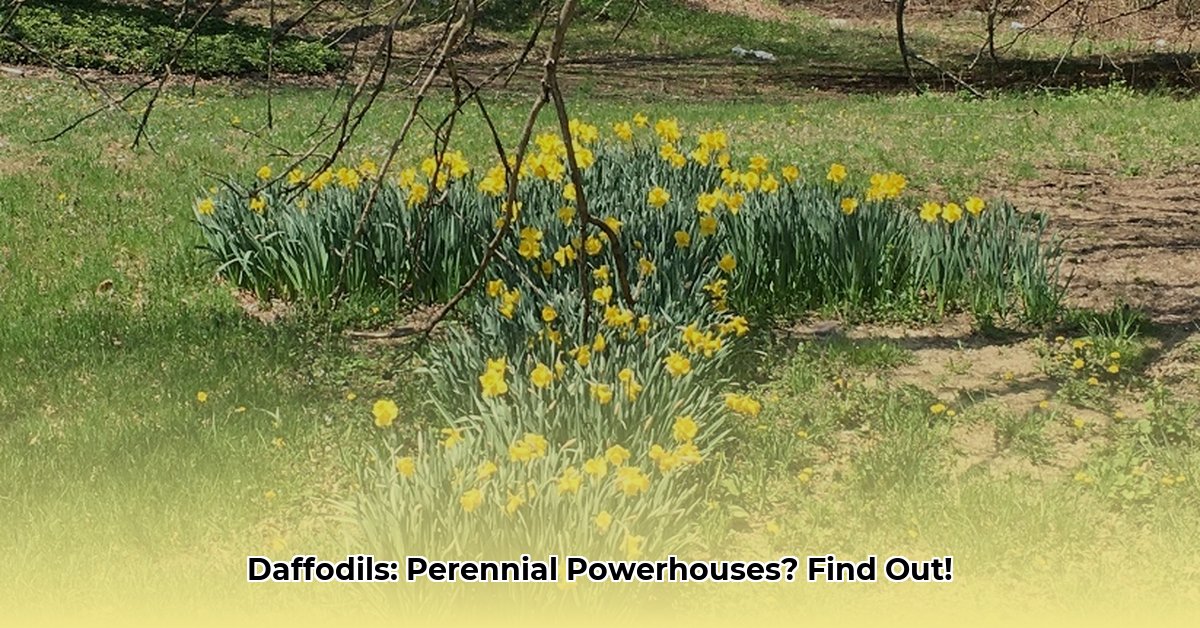Yes, daffodils are perennials. These cheerful yellow trumpets herald the arrival of spring and, with proper care, will return to brighten your garden year after year. This comprehensive guide provides everything you need to know about planting, caring for, and ensuring the longevity of your daffodils.
Understanding Perennial Power
What does “perennial” mean? Unlike annuals that complete their lifecycle in a single growing season, perennials live for more than two years, often much longer. They possess the remarkable ability to store energy, typically in underground structures like bulbs, rhizomes, or tubers. Daffodils, scientifically known as Narcissus spp., store their energy in bulbs, allowing them to lie dormant through winter and re-emerge with vibrant blooms in spring. This “perennial power” is what makes them such a reliable and low-maintenance addition to any garden.
Planting for a Spectacular Spring Show
Planting daffodil bulbs is a straightforward process, but following these key steps will ensure their long-term health and maximize their blooming potential.
Timing is Key
The optimal time to plant daffodils is in the fall, about 6-8 weeks before the first hard frost. This timeframe allows the bulbs sufficient time to establish a strong root system before the ground freezes.
Choosing the Perfect Location
Daffodils love sunshine! Select a well-drained location that receives at least six hours of direct sunlight daily. While they can tolerate some shade, especially in hotter climates, ample sunlight promotes more vigorous growth and abundant blooms. If your soil is heavy clay, amend it with compost or other organic matter to improve drainage and provide essential nutrients.
Planting Depth and Spacing
Plant daffodil bulbs with the pointed end facing upwards, at a depth of approximately two to three times the bulb’s height. A general guideline is 6-8 inches deep. Proper spacing is also crucial. While a dense display might seem appealing, overcrowding can hinder growth and reduce flowering. Space bulbs about 3-6 inches apart to allow for proper air circulation and prevent competition for resources.
Step-by-Step Planting Guide
- Prepare the Soil: Loosen the soil with a garden fork or tiller and mix in compost to create a welcoming environment for your bulbs.
- Dig the Holes: Use a trowel or bulb planter to create holes at the recommended depth (6-8 inches).
- Plant the Bulbs: Gently place the bulbs in the holes, pointed end up.
- Cover and Water: Fill the holes with soil and water thoroughly to settle the soil and encourage root development.
Nurturing Your Daffodils
Once planted, daffodils require minimal care, but a few simple practices can significantly enhance their performance.
Watering Wisely
Water regularly during the spring growing season, especially during dry periods. However, avoid overwatering, as excessive moisture can lead to bulb rot. Strive for consistently moist, but not waterlogged, soil.
Fertilizing for Flourishing Blooms
While daffodils are not heavy feeders, a light application of a balanced, low-nitrogen, high-potash fertilizer in early spring can promote healthy growth and abundant blooms. Bone meal is a popular choice among gardeners.
Post-Bloom Care: The Importance of Patience
After the flowers fade, resist the urge to immediately cut back the foliage. Allow the leaves to wither and yellow naturally, which typically takes about 6-8 weeks. This crucial period allows the leaves to photosynthesize and replenish the bulb’s energy reserves for the following year. Once the foliage has completely died back, you can trim it to ground level. Deadheading spent blooms can also help redirect energy back into the bulb.
Dividing for Continued Vigor
Every 3-5 years, or when clumps become overcrowded, divide daffodil bulbs to maintain their vigor and prevent reduced flowering. Lift the bulbs after the foliage has died back, gently separate them, and replant them at the proper depth and spacing.
Troubleshooting
Even with diligent care, daffodils may occasionally encounter problems. Here are a few common issues and potential solutions:
| Problem | Possible Cause(s) | Solution(s) |
|---|---|---|
| No Blooms | Insufficient sunlight, overcrowding | Move to a sunnier location, divide overcrowded clumps. |
| Small Blooms | Overcrowding, poor soil nutrition | Divide clumps, fertilize in early spring. |
| Yellowing Leaves | Overwatering, disease | Adjust watering practices, consult a local gardening expert for disease diagnosis. |
| Bulb Rot | Poor drainage | Amend soil to improve drainage, avoid overwatering. |
Exploring Daffodil Diversity
The world of daffodils extends far beyond the classic yellow trumpet. Explore the thirteen different daffodil divisions, each offering unique shapes, sizes, and colors, including white, orange, pink, and even multi-colored varieties. Experiment with different bloom times to create a succession of color throughout the spring season.
A Year-Round Care Checklist
| Season | Task |
|---|---|
| Fall | Plant bulbs 6-8 weeks before the first frost. |
| Winter | Allow bulbs to remain dormant. |
| Spring | Water regularly, fertilize, enjoy the blooms! |
| Summer | Allow foliage to die back naturally, divide overcrowded clumps. |
By following these guidelines and embracing the perennial power of daffodils, you can ensure a vibrant and cheerful display in your garden for years to come. Happy gardening!
- How to Get a Free Mold Inspection (and Avoid the Scams) - April 23, 2025
- How to Flush a Toilet Without Water: A Step-by-Step Guide - April 23, 2025
- The Complete Guide to Safely Disposing of Light Globes - April 23, 2025










